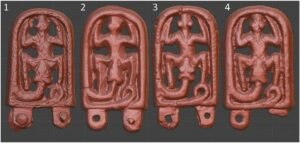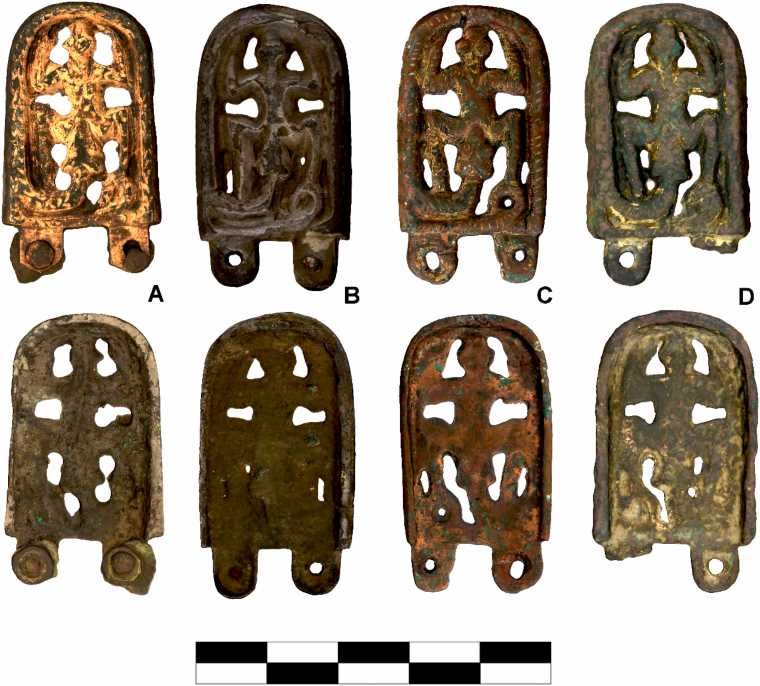Archaeologists from Masaryk University have discovered 1,200-year-old artifacts from an unknown pagan cult that depict a snake eating a frog, symbology often associated with a cosmogonic myth of creation.
Discovered in the Central Bohemian Region of the Czech Republic, the ancient belt fittings offer researchers a number of new clues about the bronze-age peoples of central Europe, whose methods and cult-like practices, including fertility practices that include frog and snake imagery, remain shrouded in mystery.
Analysis Finds “Large Similarities” and “Small Differences” Between Known and Unknown Artifacts
To better understand the nature and origin of the medieval belt fittings, researchers Jiří Macháček from The Department of Archaeology and Museology at Masaryk University in the Czech Republic and associates employed a range of scientific techniques.
According to their results, which were published in the January 2024 issue of the Journal of Archaeological Science, this included iconography, energy dispersive X-ray fluorescence (EDXRF), scanning electron microscopy (SEM), lead isotope analysis, digital morphometry, and 3D comparative prototyping.
The analysis also included artifacts found in Germany and Hungary, which, along with the Czech Republic, were also part of the “Slavic Language Zone,” which also depict similar imagery and were thought to be from the same general time period.
Based on the iconographic analysis of the imagery depicted in the 1,200-year-old artifacts, the researchers determined that “this motif represents an important cosmogonic and fertility myth, known to various early medieval populations living in Central Europe.”
“The iconographic interpretation of the snake-eating frog-like creature scene is very complicated,” they explain. “The serpent as such was sometimes displayed on Avar objects.” However, they point out that “such depictions are quite rare.” The researcher also observed that the snake is “almost never depicted fighting a frog or man-like creature,” adding to the mystery of their origin.
The material analysis of the belt fittings with similar snake-eating frog iconography showed some interesting results as well. For example, the fittings from Lány and Nový Bydžov in the Czech Republic were made with similar amounts of low-tin bronze. However, the belt fitting from Iffelsdorf had a different trace element pattern with an unusually high amount of bismuth.
Using 3D modeling to study the morphology of the mysterious belt fittings, the researchers found “large similarities” and “small differences” between them. Still, they say that this analysis “suggests that these particular artifacts were in the same place at some stage of the production or distribution process.”
At least, they note, “some of the discussed snake/frog belt ends originate from the same workshop and/or were derived from a common model.”


Analysis of 1,200-year-old artifacts ‘Shed New Light’ on Medieval Europe
In their conclusions, the researchers highlight a number of key findings from their analysis. For example, they note that three of the four artifacts analyzed “had similar metal alloy compositions with very high copper content, which was suitable for gilding.” Furthermore, a lead isotope analysis found that all belt ends examined “were made of metal of the same ore origin.”
“Thus, for the first time, we have identified a source of raw material for the production of Avar-style metalwork,” they write.
As far as who made these unique items found across a wide range of Bronze Age Central Europe, the researchers believe that a workshop found in the same place as the 1,200-year-old artifacts within the Slovak Ore Mountains is the likeliest source. This is supported by evidence showing the disparate fittings were cast from the same, or a similar, wax mold.
“It seems most likely that the strap ends were cast in a one-part mold,” the researchers explain. “The fact that from this site we have several “siblings” of the same type of object that differ slightly in some details could mean that lost wax casting was used. So, our suggestion for the production would be that a common template was used to reproduce wax models.”
Ultimately, the research team, which included individuals from The Department of Prehistory at the Natural History Museum Vienna in Austria and the Curt Engelhorn Zentrum Archäometrie (CEZA) in Mannheim, Germany, found that the exact wearers of these belt fittings were likely an unknown pagan cult. Contrary to previous beliefs by archaeologists and historians, these folks apparently interacted with other elites across a wide swath of ancient Europe, bringing their unique iconography and beliefs with them as they traveled.
“All these conclusions shed new light on the social, cultural, and political development of Central Europe in the early Middle Ages,” the researchers conclude.
Christopher Plain is a Science Fiction and Fantasy novelist and Head Science Writer at The Debrief. Follow and connect with him on X, learn about his books at plainfiction.com, or email him directly at christopher@thedebrief.org.

